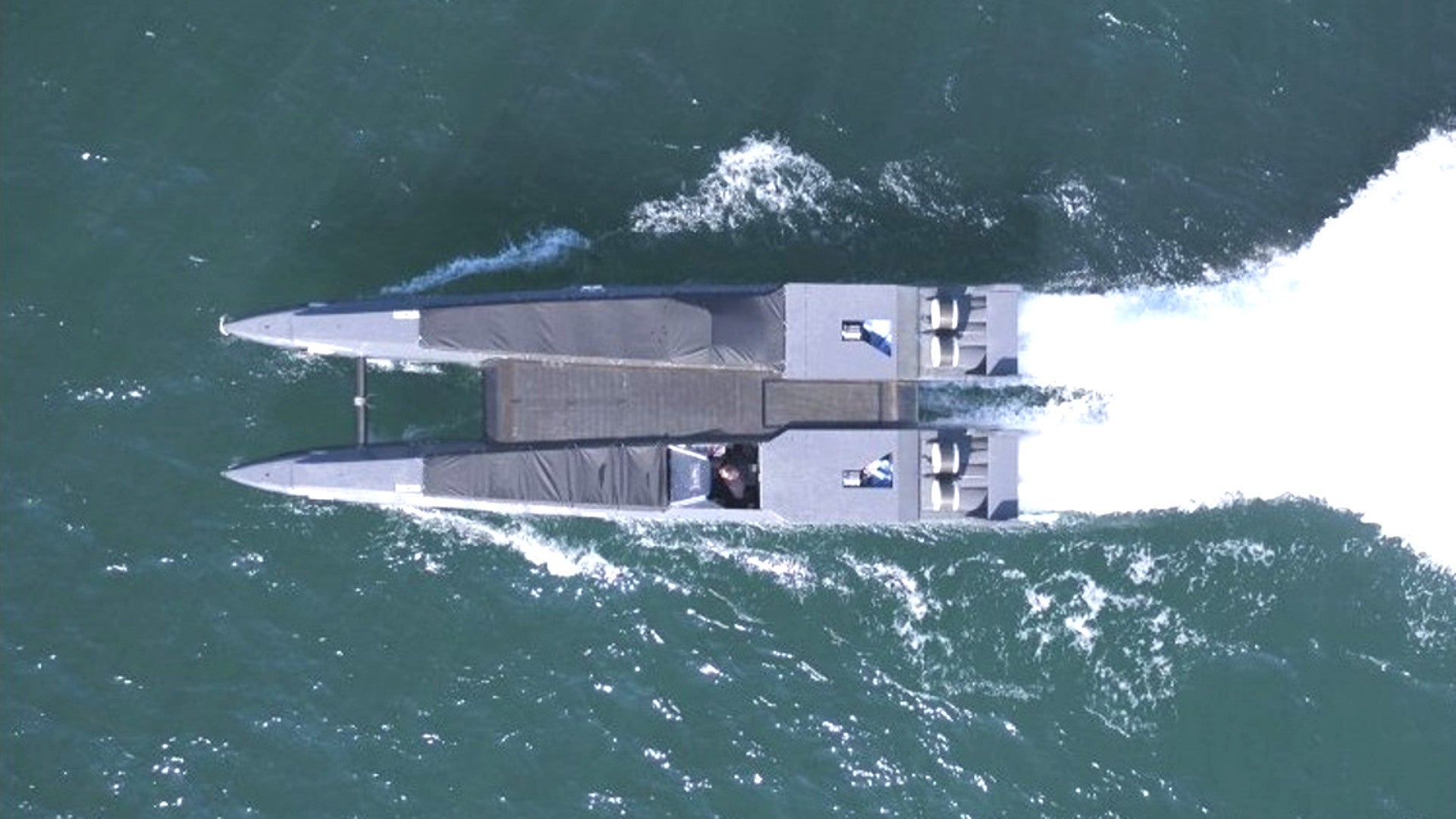It’s something of an open secret that maritime special operations forces around the world rely on a wide array of highly specialized water craft, such as high-speed, low-profile speed boats, miniature submarines, and more. Now, one company, SubSea, is trying to combine a number of these features into single design it calls the Diver Delivery Unit (DDU), which can transform from a speedboat to a mini sub and back again.
The DDU concept is centered on a symmetrical twin-hull design, both of which could carry personnel or other equipment. The United Kingdom-based firm says the final arrangement will be both modular and scalable to allow for a wide variety of missions, including special operations raids, hunting drug smugglers, patrolling ports, and even performing research and exploration tasks.
Eight electric fans will power the boat underwater, with two at the rear of each hull and another two in each of the twin bows. The front pairs retract into the hulls when the craft is riding on the surface so it can maintain its streamlined profile. SubSea says that battery technology from high-performance Formula-E electric race cars will power these engines.

Multi-fuel diesel engines will power water jet drives in both hulls for high-speed travel on the surface. SubSea doesn’t say on its website what the craft’s top speed might be, either on the surface, or below the water, or what kind of range it could have in its final form. The company does say the design will allow for “full hydrodynamic control” at depths of almost 115 feet.

The design suggests it could be an extremely fast. Both hulls have a very slender shape designed to cut through the water rather than skip on top like many other high-performance speed boats. Not only does this help improve performance, but it reduces the strain on operators as well, who end up slamming up and down in most high-speed watercraft. Shock absorbing seats can only do so much to alleviate this battering.
As of 2017, there are a number of these so-called “Very Slender Vessels,” or VSVs in military service around the world. One of the best known types is the sleek looking and stealthy WP-18 strike craft, which is reportedly the fastest naval watercraft in the world.

Manufactured by Abu Dhabi MAR in the United Arab Emirates, the WP-18 has a top speed of more than 75 miles per hour and a range of approximately 400 miles even at a brisk cruising speed of only 54 miles per hour. The UAE’s military operates these and the Abu Dhabi MAR exported additional examples to Mozambique’s Navy.
In January 2017, Safehaven Marine in Ireland, already well known for its sleek Baraccuda patrol boats, launched its own VSV design, the XSV-17 “Thunder Child.” Slightly slower than the WP-18, it still has a cruising speed of more than 45 miles per hour and is capable of accelerating up to nearly 70 miles per hour when necessary.

The basic concept is by no means new, with the U.K.’s Special Boat Squadron having acquired a single experimental VSV in 1999 and the U.S. Defense Advanced Research Projects Agency starting a similar project that same year, according to GlobalSecurity.org. Satellite imagery shows North Korea is experimenting with the VSV concept and there is at least one known example of drug smugglers making use of an amazingly slender-hulled craft.
But SubSea’s design looks to be the first time someone has attempted to build a fully-submersible craft using these design principles. It’s an idea that makes perfect sense if the firm can make it work.
Rapidly improving shore-based defenses, including long-range cruise and ballistic anti-ship missiles, integrated air defenses, and precision artillery, mean that sea-borne raiders and larger amphibious forces both face increasing risks, especially in narrow or otherwise constrained waterways. Simply building craft with low-observable shapes offers some protection against radar and other sensors, but doesn’t necessarily reduce the visual, sound, or infrared signatures of the craft.
A craft like the DDU, which can utilize high speed or the ability to hide under the waves, would give special operations forces multiple options to try and avoid detection during a single mission, allowing them to get close to targets to both gather intelligence or strike. SubSea also says it will be possible to air drop the craft or sling it underneath a helicopter. The company hopes the final version will be able to operate autonomously, able to drop off divers and then return to a mothership, sea base, or other preset location automatically, as well.

It’s the same sort of logic behind the HSP Technologies’ Hypersub, which the U.S. Marine Corps evaluated in April 2017. However, this craft has a much slower top speed on the surface, just 30 miles per hour, than what SubSea looks to be aiming for with its DDU.
So far, SubSea doesn’t appear to have attracted any consumers and its craft is still very much in the prototype phase. It built the initial version in 2016 and had successfully tested it on the surface earlier in 2017. The company then began submerged trials ahead of the annual Defense and Security Equipment International (DESI) exhibition, which began on Sept. 12, 2017 in London, England, according to IHS Jane’s.
It remains to be seen if the company can generate interest in a military version or if the final version might end up a plaything for billionaire oligarchs who are looking for something new to add to their fleets of private mega yachts and submarines.
Contact the author: joe@thedrive.com
